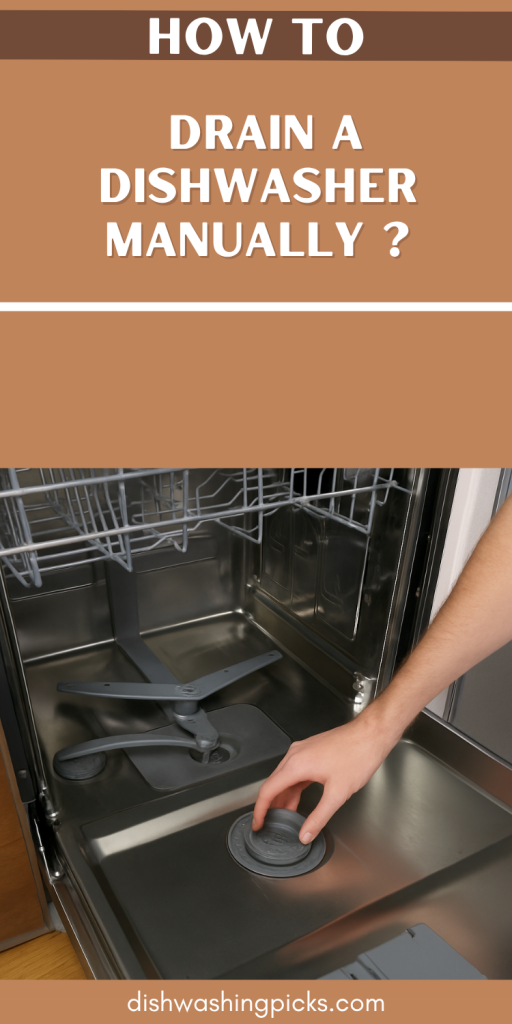
So… your dishwasher isn’t draining, huh?
Ugh, that moment when you open it after a cycle, expecting sparkly clean dishes, and instead—boom—there’s this weird pool of nasty water just sitting at the bottom. Ew. Why. What did we ever do to deserve this?
But don’t worry—this isn’t the end of the world. It feels dramatic, but honestly, draining a dishwasher manually isn’t rocket science. You don’t need to call a plumber yet (unless things are, like, way beyond messy). You can probably fix it with a little bit of patience, a towel, and maybe some gloves if you’re squeamish.
Let’s walk through it together. Like… right now.
First, Take a Deep Breath. Then Unplug That Thing.
Okay, before you stick your hands into mystery dishwasher soup—please unplug it.
Yeah, I know it sounds obvious, but you’d be surprised how many people just skip this part. It’s still an electrical appliance, and sticking your hands into water + wires = not a vibe.
If it’s hardwired in and not plugged into a regular outlet, just flip the breaker off. Better safe than zapped.
Step One: Scoop the Water Out (Yes, Literally)
Alright, here comes the “fun” part.
You’re gonna need:
- A cup or small container (just something to scoop with)
- A bowl or bucket to dump the water into
- And… a towel or two. Or five. Up to you.
Start scooping out the water into the bucket. No fancy tools—just good old cup-to-bowl action. It’s a bit tedious, but it works. Once you get most of it out, grab a towel and soak up the leftover puddles at the bottom.
Try thinking of it like this: you’re bailing out a tiny boat, and this boat’s been through some stuff.
Step Two: Pop Out the Bottom Rack and Check the Drain Area
Now that it’s (mostly) dry down there, slide the bottom rack out and set it aside.
What you’re looking for is the drain, usually at the back or in the center-bottom of the dishwasher. It might be under a little mesh screen or grate. Sometimes it’s got a cover you can twist off. Take a peek around.
If there’s food gunk, paper, glass shards, or anything weird in there—grab it (gloves help, trust me). A lot of drainage problems are just… gross stuff stuck where it shouldn’t be.
Step Three: Clean the Filter (A.K.A. The Forgotten Hero)
Okay, listen. If you’ve never cleaned your dishwasher’s filter… well, now’s the time.
Look near the drain area—there’s probably a cylinder-shaped filter you can twist and lift out. Take it to the sink, rinse it out with hot water, maybe give it a gentle scrub with an old toothbrush if it’s real nasty.
Filters get clogged with food, soap scum, and all kinds of things that your dishwasher just can’t process on its own. Poor thing’s been struggling.
Imagine this: You’re trying to breathe through a paper towel. That’s your dishwasher with a clogged filter.
Step Four: Check the Drain Hose (Only If You’re Feeling Brave)
If nothing so far has helped and the water keeps pooling after a cycle, it might be the hose that drains the water out to your sink or garbage disposal.
It’s usually connected at the back of the dishwasher or under the sink. You can:
- Unhook it carefully (put a bucket under it—there’s probably water in there).
- Check if it’s kinked or blocked.
- Blow through it (yep, like a trumpet).
- Run some water through it and see if it flows out clean.
If it’s clogged, sometimes flushing it with hot water and vinegar helps. Worst case? You replace it—but let’s not go there unless we have to.
Step Five: Run a Test Cycle (Fingers Crossed)
Put the filter back in, pop the bottom rack back into place, and give it a rinse cycle with no dishes inside.
If everything drains and you don’t see water pooling at the bottom—boom! You did it. You manually drained your dishwasher and fixed the problem like a total DIY boss.
If it still doesn’t drain? Okay, now it might be time to call in a pro. But at least you tried. And honestly? That’s more than most people do.
Final Thoughts: Don’t Let It Happen Again (If You Can Help It)
- Rinse off big food chunks before loading dishes (yeah, we know you “don’t need to,” but still).
- Clean the filter once a month. Just do it.
- Run hot water in the sink before starting the dishwasher—helps things heat up faster.
- Do a vinegar rinse every now and then. Your dishwasher deserves it.
So, there you go. Next time your dishwasher floods itself, don’t panic. You know what to do. You can scoop, clean, check, and save the day—all before lunch.
Oh, and if your roommate, partner, or sibling ever yells, “The dishwasher’s broken again!!” …you get to be the calm, dishwasher whisperer. Go you.
